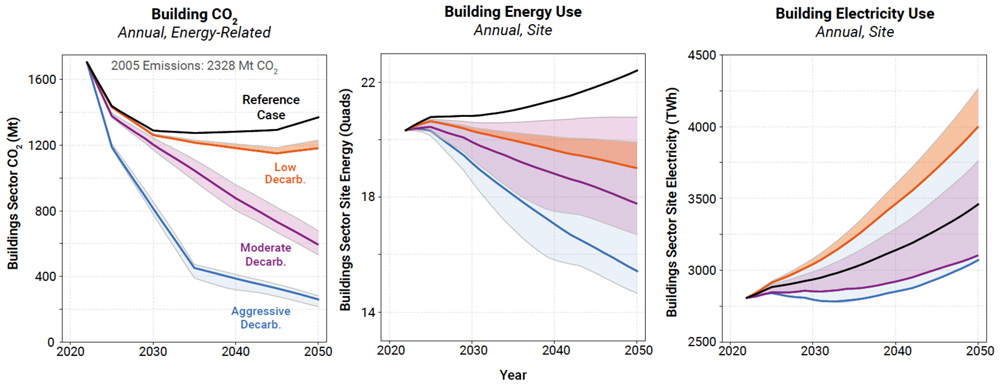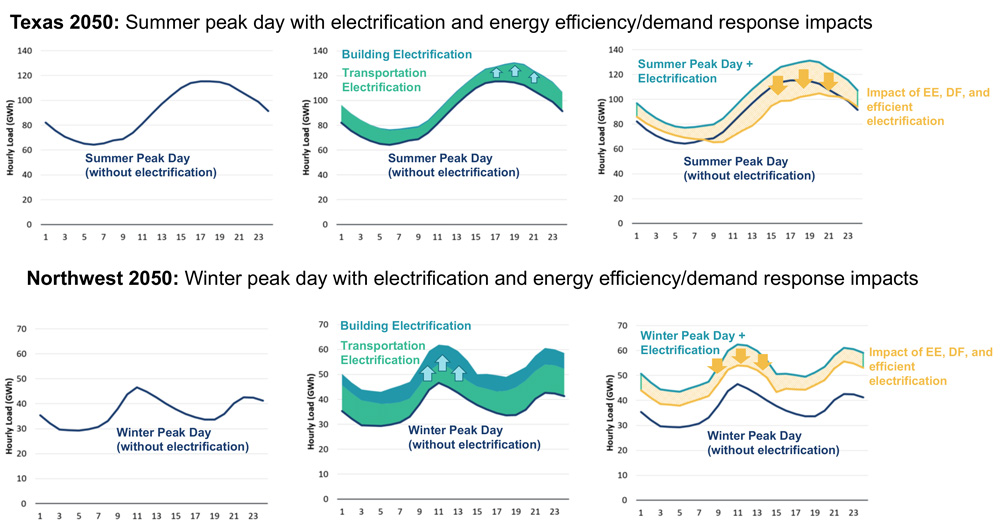FERC issued Order 1920, its long-awaited final rule on long-term regional transmission planning and cost allocation, during a special meeting May 13, but it could not fulfill hopes for a unanimous vote (RM21-17).
The order requires regional transmission planners, including ISOs and RTOs, to plan at least 20 years ahead of time using multiple scenarios while taking into consideration seven benefits:
-
- avoided or deferred reliability transmission facilities and aging infrastructure replacement;
- reduced loss-of-load probability or lower planning reserve margins;
- production cost savings;
- lower line losses;
- lower congestion from transmission outages;
- mitigation of extreme weather events and unexpected system conditions; and
- capacity cost benefits from reduced peak energy losses.
Planners will have to give state entities six months to agree on a cost-allocation method, but they also have to propose a default method. They can decide to push through their default method and will not be required to file any alternative states come up with.
That ability to override state desires — plus the end of the separate consideration of economic, reliability and public policy lines — led to Commissioner Mark Christie dissenting on the entire order, while Chair Willie Phillips and Commissioner Allison Clements filed a joint concurrence.
“Not everybody is going to get everything that they want,” Phillips said during the meeting. “I don’t even get everything that I want, but that is the nature of these large proceedings and these large rules here at FERC. This rule cannot come fast enough. There is an urgent need to act to ensure the reliability and affordability of our grid. We are at a transformational moment for the electric grid with phenomenal load growth from a domestic manufacturing boom, unprecedented construction of data centers fueling an AI evolution, and ever-expanding electrification.”
The resource mix is at an inflection point with aging infrastructure needing replacement, and a higher incidence of extreme weather has cost consumers billions of dollars over the past decade, he added. Transmission expansion has not kept pace with the changes, falling to an all-time low in 2022, and much of that was “Band-Aid” fixes, Phillips said.
Christie said the Notice of Proposed Rulemaking was a bipartisan deal, but that bipartisanship did not carry forward into the final rule. (See FERC Issues 1st Proposal out of Transmission Proceeding.)
In addition to ending public policy as a separate consideration, Christie also criticized the final rule’s requirement that planners consider demand from large corporate customers favoring specific generation types to serve their operations.
“If we’re going to mix reliability projects with public policy projects, and these corporate-driven, preferred purchasing projects, then it’s only fair that state regulators have to have the ability to consent to the planning criteria, and especially the cost allocation in a big, big multistate RTO, like PJM,” Christie said in an interview. “That is absolutely essential. So that’s not in there now. There’s no requirement that states have to consent.”
The NOPR did not spell out what would happen if states cannot come to an agreement, instead asking for comment on the issue. Clements told reporters that the decision to have a federal backstop made sense based on the record.
“We need to have a federally jurisdictional backup if the states don’t come to agreement, and that is why we have a backstop ex ante approach,” Clements said. “States don’t have to use it; if they get together in a region and want to do something different — great.”
The point where state regulators and an RTO might split on cost allocation is not going to occur until after the rule is implemented, she said. “But I wouldn’t suggest it’s a wise approach,” Clements said of regional planners overriding states. “I think transmission providers want this to work as well and are looking forward to working with the states.”
Christie questioned why the majority even voted to let regional planners, including ISO/RTOs and groups of utilities outside them, override state cost-allocation preferences.
“If you don’t think they’d ever do it, then why wouldn’t you agree to give the states the ability to consent?” Christie said. “Because the fact is, they can ignore it.”
Phillips noted that he and Christie knew each other as members of the Mid-Atlantic Conference of Regulatory Utilities Commissioners before they came to FERC. He said he would never support a rule that tramples states’ rights in the planning process.
“There’s a lot that Commissioner Christie said that I simply do not agree with,” Phillips said. “But I do agree with this: The most important job of our commission is reliability. I’ve been saying that since Day 1. So let me be clear now, because this rule is about reliability and affordability: I have complete confidence that it will be legally durable and that it will be upheld.”
Another area where the three commissioners could not agree is whether the rule is reacting to the industry’s realities or actively seeking to drive the grid toward a preferred future.
“It is not our job to do resource planning,” Clements told reporters. “States, private actors — they engage in choosing what kind of resources they want to have. It is the commission’s job to facilitate reliability and affordability of the transmission system in light of the choices that states and other actors are making outside of the agency.”
Christie argued that the rule was being pushed out along with other policies the Biden administration favors. He noted in his dissent that he quotes several press reports linking the transmission rule to efforts to combat climate change.
“What this is doing here is attempting to enact a major policy agenda that has never been passed by Congress,” Christie said. “And that alone makes it a major question. So, it’s a very important point in my dissent that this is not within the authority of FERC under the Federal Power Act.”
The order will go into effect 60 days after its publication in the Federal Register. Transmission providers will be required to submit compliance plans for most of the order’s requirements within 10 months of the effective date.
FERC Pulls Back on ROFR Rollback
One aspect of the NOPR that drew considerable debate was the proposed partial rollback of Order 1000’s elimination of most federal rights of first refusal, which opened regionally planned lines to competition. The commission had proposed establishing a conditional ROFR when a utility works with a partner on a project.
The change was a major priority for utilities and their trade groups, including the Edison Electric Institute and WIRES Group, but it was opposed by competitive transmission developers, consumer groups and the Federal Trade Commission.
The commission required transmission providers to identify opportunities to modify in-kind replacement of existing facilities to increase their transfer capability, known as “right-sizing.” Utilities will get to keep a federal ROFR over such right-sized projects that are in their territories.
Order 1977 on Backstop Transmission Siting
FERC also issued Order 1977, which implements its new congressionally mandated authority to site transmission lines in a National Interest Electricity Transmission Corridor even when state regulators reject them (RM22-7). All three commissioners supported this order.
The order “includes a Landowner Bill of Rights, codifies an Applicant Code of Conduct as one way for applicants to demonstrate good-faith efforts to engage with landowners in the permitting process, and directs applicants to develop engagement plans for outreach to environmental justice communities and tribes,” FERC said.
The one major change from the proposal was that FERC will not let transmission developers file for its siting approval at the same time as a state is reviewing a line. They will instead have to wait a year.
Many states argued that allowing transmission developers to file at FERC while also pursuing a state certificate would effectively usurp their authority. (See FERC Backstop Siting Proposal Runs into Opposition from States.)
The order will take effect 60 days after its publication in the Federal Register.
Initial Takes
Senate Majority Leader Chuck Schumer (D-N.Y.) held a press conference call while FERC was still meeting to praise the final rule.
“The clean energy incentives included in the Inflation Reduction Act have been a huge success,” Schumer said. “But much of that success would be lost without the ability to bring power from places that generate renewable energy to communities all across the country. A new historic advancement in our transmission policies has been desperately needed, and the rules released by FERC today will go a long way, a very long way to solving that problem. Simply put, these new rules will mean more low-cost, reliable, clean energy for the places that need it most.”
Many proposed bills have been introduced this Congress to address transmission and other permitting issues, with Senate Energy and Natural Resources Committee Chair Joe Manchin (D-W.Va.) and Ranking Member John Barrasso (R-Wyo.) trying to get a deal through to simplify building infrastructure. Schumer said such efforts will be hard to get past a divided Congress this year.
“I’ve told Joe Manchin it’s going to be virtually impossible to get something done,” he said.
For his part, Barrasso blasted “FERC’s partisan vote,” arguing it would only add to electricity’s growing costs.
“Today’s decision will force customers — often in rural states — to pay for new transmission lines even when those lines don’t provide any meaningful benefit to them,” Barrasso said. “It is the Holy Grail for liberal politicians in California and New York and corporate executives who want others to foot the bill for their climate obsession. I have no doubt the cost of energy will be at the top of every voter’s mind later this year.”
House Democrats welcomed the final rule, with Reps. Sean Casten (D-Ill.) and Mike Levin (D-Calif.), co-chairs of the Sustainable Energy and Environment Coalition’s Clean Energy Deployment Task Force, calling it a vital step toward a fully clean economy. Despite Schumer’s doubts, they said they would like to pass additional legislation on transmission — especially their own Clean Electricity Transmission Acceleration Act.
“This rule takes steps towards ensuring our grid is meaningfully planned and the costs of the necessary transmission buildout are fairly distributed by those who will benefit from the new capacity,” they said in a joint statement. “Americans today are already bearing the costs of an improperly planned grid; transmission planners have thus far not adequately accounted for the new forms of cheap, clean energy that are being deployed on the grid at an accelerating pace. A reliable, affordable and clean grid is only achievable with proper, comprehensive and forward-looking grid planning.”
Americans for a Clean Energy Grid praised the rule, saying it ensures the grid will be planned in a proactive and comprehensive way.
“Now, it’s time to implement this rule,” ACEG Executive Director Christina Hayes said. “Regions must develop their compliance filings over the next few months so that transmission can be planned and developed as soon as practicable. We look forward to working with and supporting the interested parties as they move forward with the next steps in compliance and build out the 21st-century grid.”
Advanced Energy United welcomed the rule, saying it would help lower consumer bills by making a more efficient grid and opening access to cheap power.
“Families and businesses are paying the price for utilities’ and grid operators’ failure to address our critical electricity infrastructure needs,” CEO Heather O’Neill said in a statement. “Building more multistate transmission lines unclogs the traffic jams on America’s electricity superhighways and unlocks our ability to keep up with our growing energy needs. This FERC order sends the message that transmission planning needs to change and recognizes that states deserve a central role in ensuring a reliable electric grid built for the future.”
EEI was not as enamored as the clean energy trade groups, citing disappointment with the decision not to roll back Order 1000’s ROFR provisions, among other issues.
“Additionally, the failure to provide regional flexibilities for evaluating project benefits in the final rule will lead to longer compliance processes and, ultimately, could slow the development of much needed transmission projects,” EEI Vice President of Regulatory Affairs Phil Moeller said in a statement. “A one-size-fits-all approach does not work, as different regions have different needs and different states have different policies.”
Environmental groups generally praised the final rule, with Sierra Club Executive Director Ben Jealous saying it “follows the letter of the law” and will save ratepayers money.
“As President Biden’s Inflation Reduction Act continues to usher in the clean energy future through deployment of solar, wind and battery storage, this transmission standard will allow utilities to deliver Americans clean, affordable electricity, even in the face of rising demand and extreme weather caused by climate change,” Jealous said in a statement. “With the standard now in place, FERC must be vigilant to ensure strong implementation in order to maximize the benefits for reliability and consumers.”
K Kaufmann contributed to this report.







